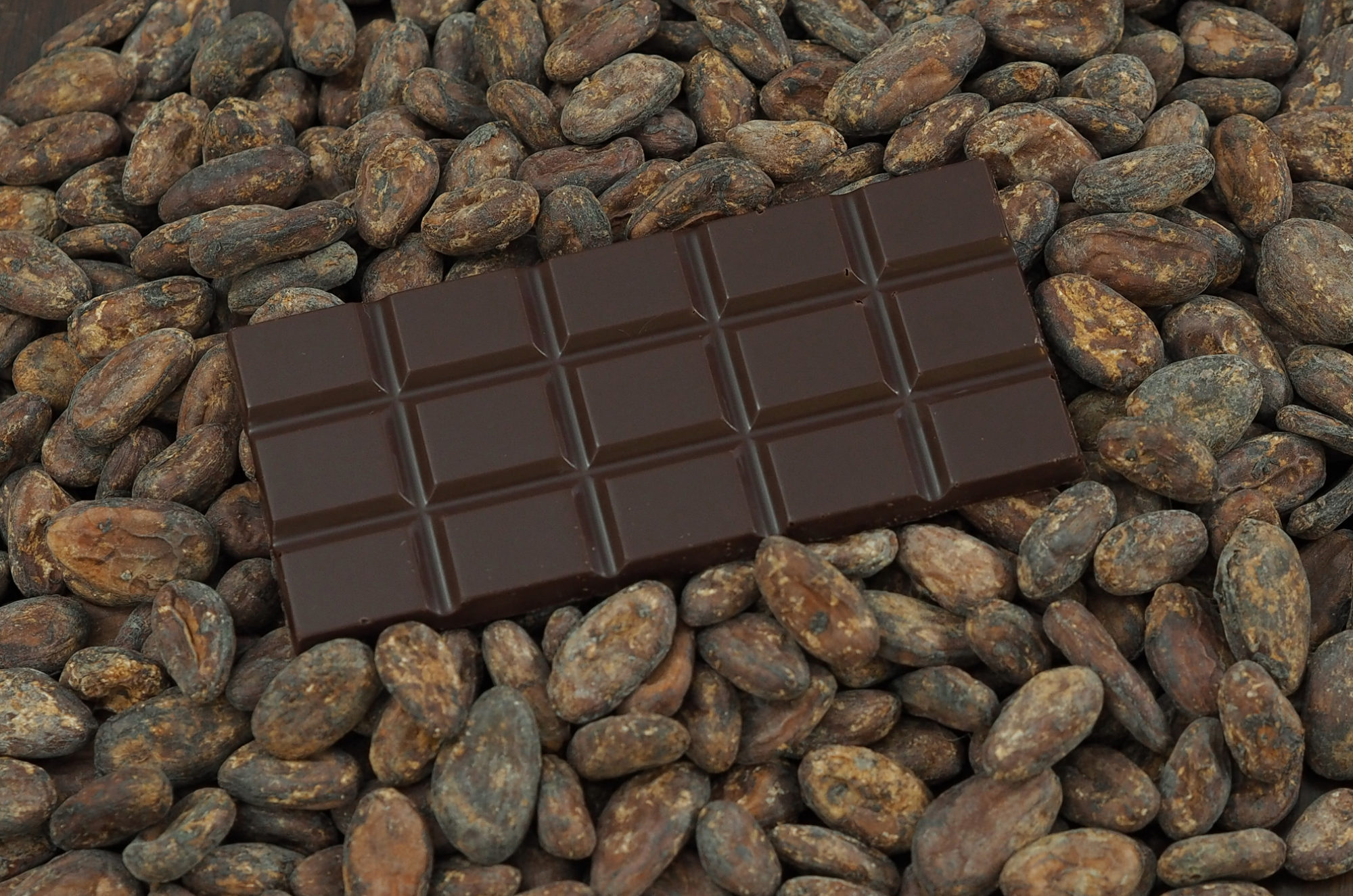
Welcome to Resplendent Chocolate
Learn how we make our small-batch craft chocolate, what we offer, and other chocolatey info!

Artisanal Homemade Chocolate

Welcome to Resplendent Chocolate
Learn how we make our small-batch craft chocolate, what we offer, and other chocolatey info!

Theobroma cacao – “Food of the Gods”
Cacao grows in warm, humid areas usually located within 20 degrees north or south of the equator. Genetics plays a major role in hardiness, harvest yields, and flavor. Many large chocolate companies choose higher yields over flavor. Craft chocolate focuses on fine flavor cacao.

Harvesting
Cacao trees produce many small blooms that develop into pods all over the trunk and branches. Once ripe, pods are removed and split open. The seeds, or cacao beans, inside are covered in a white, fruity-tasting pulp.

Fermentation and Drying
These wet beans are piled into large bins and are covered. Microorganisms begin the fermentation process, which includes several days of sitting and turning/stirring. The white fruit “sweats off” and leaves the cocoa bean behind. They are then left out to dry before being bagged and shipped.

Sorting and Roasting
Once we receive the cocoa, we remove any debris and sort out poor-quality beans. We then roast the beans using specific roasting profiles that complement each origin’s unique flavors.

Cracking and winnowing
The beans are then broken into shells and nibs. Nibs are the broken-up portions of the bean. This mix of shells and nibs is run through our winnower—a device that uses airflow to remove the lighter shells from the heavier nib.

Refining and Tempering
Next, we run the ingredients through our melanger—a machine that crushes and liquefies the cocoa nibs and other ingredients to the desired particle size. The melanger usually runs for 24+ hours per batch. The Chocolate is then ready to be tempered. Tempering helps properly align the cocoa butter particles as they crystallize. This gives the chocolate a nice snap, a proper sheen, and raises the melting temperature. It is now ready to be poured and packaged.
We craft our bean-to-bar chocolate using only the finest flavor cocoa beans from ethical sources. Using minimal ingredients allows each of our single-origin bar’s unique flavors and varied tasting notes to shine through.

Caracol – 70% dark
An absolutely enjoyable dark chocolate with complex fruity and floral notes.
– Maya Mountain, Belize cocoa beans – organic (certified)
– Cane Sugar – organic (certified)
– Cocoa butter – organic (certified)

Tikal – 60% dark
These beans give a bright, fruity, and somewhat acidic flavor. The flavors balance out nicely in this slightly sweeter dark chocolate.
– Chivite, Guatemala cocoa beans – organic (certified)
– Cane sugar
– Cocoa butter – organic (certified)

Copán – 55% dark milk
A bold, complex flavor that can be hard to pin down. Hints of coffee, caramel, earthiness, and spice combine with the low bitterness of this bean to give a unique flavor.
– Wampusirpi, Honduras cocoa beans – organic (non-certified)
– Cane sugar
– Whole milk – organic (certified)
– Cocoa butter – organic (certified)

Machu Picchu – 50% dark milk
These Nacional cocoa beans are among the rarest in the world. They make a wonderful chocolate that everyone can enjoy due to their low bitterness and intense, rich chocolatey flavor.
– Marañón, Peru cocoa beans – organic (non-certified)
– Whole milk – organic (certified)
– Cane sugar
– Cocoa butter – organic (certified)

Chichén Itzá – 36% caramelized white chocolate
Caramelized white chocolate—aka Blonde chocolate—is made by cooking white chocolate low and slow. Gone is the simple sweetness of white chocolate; it now has a wonderful, complex flavor.
– Cocoa butter – organic (certified)
– Cane sugar
– Whole milk
– Whole vanilla bean
If you would like to order or make a request, please contact us using the form below.
Tasting
Enjoying craft chocolate is a multi-sensory experience. Note the distinct color from that origin’s beans and the shine of the surface. Enjoy the varied aromas that will play important roles in flavor. The snap when breaking a piece off is indicative of being well-tempered (milk and white chocolates will have softer snaps). Take a piece, chew minimally, and then let the chocolate melt in your mouth. Assess the many textures, sensations, flavors, and finish. To better enjoy your chocolate, make sure it is at room temperature and cleanse your palate before each new type of chocolate.
Pairings
Fine chocolate pairs well with many of your other favorite fine foods and drinks. With hot drinks, like coffee, tea, or herbal tisanes, alternate trying the chocolate or the drink first to decide which method you prefer. When pairing with craft beer, wine, or spirits, take a bite of the chocolate and allow it to start melting before taking a drink. Experiment and discover your own favorites, or follow the links below for established pairings.
Tea Pairing – Tea Muse
Tea Pairing – Cup Above Tea
Tea Pairing – The Cup of Life
Coffee Pairing – Heart of the Desert
Coffee Pairing – The Queen Bean
Beer Pairing – The Spruce Eats
Beer Pairing – Serious Eats
Wine Pairing – Wine Folly
Wine Pairing – The Spruce Eats
Wine and Spirits Pairings – To’ak Chocolate
Cheese Pairing – Cheese Grotto
Cheese Pairing – Chocolopolis
Extensive Food Pairings – She Knows
Food Pairings – Byron Talbott